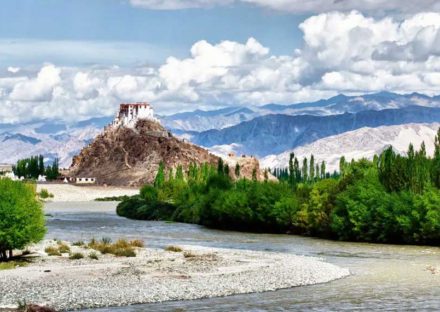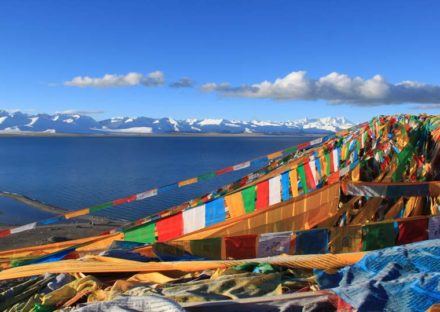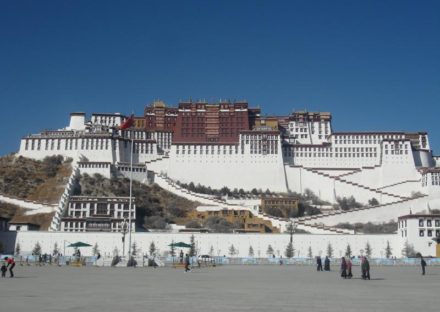Tour overview
Duration : 7 Days Tour
Destinations : Kathmandu – Kodari – Zhangmu – Xegar – Xigatse – Gyantse – Lhasa -Kathmandu
Day 01 – Kathmandu – Kodari (Drive Trek) Kodari – Zhangmu
This morning we depart Kathmandu by surface on a scenic drive to Kodari (Nepal-Tibet border), through the beautiful Nepalese countryside. We leave our vehicals here and start a short walk of about one hour 30 minutes uphill with porters to Shangmu Immigrations – known to Nepalese as Khasa, hangs on a cliff face, its boom town architecture having a temporary look; even the monastery roofs are sheadthed in corrugated iron sheets and is situated at a height of 2,500 m. Overnight stay at the Hotel.
Day 02 – Zhangmu – Xegar (Drive)
Today we drive uphill to the highest plateau of the world with the typical view of Tibetan landscape, crossing over Nyalam Pass (3,800 m) and Lalung-La (Pass) at 5,050m, with views of beautiful Himalayan Ranges panorama including the Mt. Everest (8,848 m) to Zhangmu (244 Kms). Also called “new tingri”, is surrounded by mountains, Zhangmu is another town that lies in the shadow of a great fortress. Even in ruins it is majestic. Seeming to grow out of the craggy brown rock, its sinous wall bristles with watchtowers like stegosaurus spines. Isolated in 1855 by marvading Nepalese in search of booty, the Gurkhas cut off the Dzong’s water supply and settled in for a long seige. Overnight stay at the Hotel.
Day 03 – Xegar – Xigatse (Drive)
Drive We continue on our drive to Lhatse (T-cross to Mt. Everest), and crossing over the Gyatsola Pass at 5,220 m, which is the highest enroute to Xigatse (240 Kms). Xigatse is the second largest town in Tibet and the capital of Tsang, lying 354 Kms. west of Lhasa at an altitude of 3,810 m. Overnight stay at the Hotel
Day 04 – Xigatse – Gyantse (Drive)
Drive This morning we will visit the Panchen Lama’s Tashilhumpu Moanastery, and continue on our drive to gyantse (90 Kms) – is a pastoral town between Lhasa and xigatse. It is 264 Kms. southwest of Lhasa, and still retains the charm of a traditional Tibetan town untouched by modern expansion. As a crossroad on the principle trade route to India, it used to be renowned for the excellence of its carpets. The compound, encircled by on impressive wall, once contained 19 monasteries, presided over by the still intact fortress perched atop a nearby mountain. Later in the day visit the Kumbum Stupa and Phalkor Monastery. Overnight stay at the Hotel.
Day 05 – Gyantse – Lhasa (Drive)
We continue on a full day picturesque drive crossing over Karola Pass at 5,010m, Kambala Pass at 4,794 m. and a colourful Yamdrok Lake, sometimes along the Tibetan lifeline river Brahmaputra also known as yarlung Tsangpo, to the capital town Lhasa (264 Kms).
Day 06 – Lhasa (Drive)
Today we will visit the Jokhang Temple, situated in the heart of Old Lhasa, it houses Tibet’s most precious religious relic, a golden Shakyamuni Buddha which was brought as a gift bythe Chinese Princess Wen Cheng on the occasion of her wedding to the Tibetan King, Songtsen Gompo. Surrounding the Jokhang Temple is the bustling Barkhor Market place which is the religious and social focus of Lhasa.
Later in the day visit the Potala Palace, this legendary palace built atop a single hill is synonymous with Tibet by the first foremost king Songtsen Gompa. It was expanded to its present structure during the 17th century by the 5th Dalai Lama. This 13 story 1000 room citadel served as the headquarters of the former “church-state” of Tibet and was home to successive Dalai Lamas, who from the latter half of the 18th century used it as their Winter palace. Overnight stay at the Hotel.
Day 07 – Lhasa -Kathmandu (Flight)
Early this morning you will be picked up from you respective hotel to be transferred in time to Gangaar airport to connect your flight to Kathmandu.
Tibet is a unique and culturally rich region, known for its stunning landscapes, Tibetan Buddhism, and vibrant culture. Planning a trip to Tibet can be a bit challenging due to the need for permits and restrictions on independent travel. Many travelers opt for organized Tibet tour packages to ensure a smooth and enjoyable experience. Here’s a general guide on what to expect and how to find Tibet tour and travel packages:
1. Choose a Reputable Tour Operator:
Research and choose a reputable tour operator that specializes in Tibet tours. Look for reviews and recommendations from other travelers.
2. Permits and Documentation:
Tibet requires special permits for foreign travelers, including the Tibet Travel Permit and, in some cases, the Alien Travel Permit or Military Permit. Your tour operator should assist you in obtaining these permits.
3. Tour Duration:
Decide how long you want to spend in Tibet. Tour packages can vary in duration, from a few days to several weeks.
4. Itinerary:
Review the itinerary offered by the tour operator. Ensure that it covers the places you want to visit in Tibet, such as Lhasa, Shigatse, Gyantse, Everest Base Camp, or other destinations.
5. Accommodations:
Check the types of accommodations provided in the package. You can choose from a range of options, including hotels, guesthouses, or even camping at higher altitudes.
6. Transportation:
Find out what modes of transportation are included in the package. This may involve flights to Lhasa or overland travel from neighboring regions like Nepal.
7. Guided Tours:
Most Tibet tours include guided tours to important cultural and historical sites, monasteries, and natural attractions.
8. Altitude Considerations:
Tibet has a high altitude, so it’s important to acclimatize properly. Look for packages that include a gradual ascent to higher altitudes to reduce the risk of altitude sickness.
9. Food and Meals:
Check if meals are included in the package. Tibetan cuisine is unique and varies by region, so this can be an interesting culinary experience.
10. Cultural Experiences:
– Some tour packages may offer opportunities to participate in local Tibetan festivals, ceremonies, or cultural experiences.
11. Budget:
– Consider your budget and choose a tour package that fits your financial constraints. Prices can vary widely based on the duration and level of comfort.
12. Season and Weather:
– The best time to visit Tibet is during the spring and autumn months when the weather is more temperate and stable. Be mindful of weather conditions when planning your trip.
13. Travel Insurance:
– Ensure you have appropriate travel insurance, including coverage for high-altitude destinations.
14. Respect Local Customs:
– Familiarize yourself with Tibetan customs and show respect for local culture, especially when visiting monasteries and religious sites.
Keep in mind that political and travel regulations in Tibet can change, so it’s important to stay updated on the latest requirements and restrictions. Additionally, it’s recommended to book your Tibet tour packages well in advance to secure permits and accommodations, as Tibet can be a restricted region for tourists. Always travel responsibly and enjoy the unique cultural and natural wonders of Tibet.
Included
- Airfare
- Local Transportation
- Accommodations
- Professional Guide
Not Included
- Entrance Fees
- Guide Gratuity
Day 1
This morning we depart Kathmandu by surface on a scenic drive to Kodari (Nepal-Tibet border), through the beautiful Nepalese countryside. We leave our vehicals here and start a short walk of about one hour 30 minutes uphill with porters to Shangmu Immigrations - known to Nepalese as Khasa, hangs on a cliff face, its boom town architecture having a temporary look; even the monastery roofs are sheadthed in corrugated iron sheets and is situated at a height of 2,500 m. Overnight stay at the Hotel.
Day 2
Today we drive uphill to the highest plateau of the world with the typical view of Tibetan landscape, crossing over Nyalam Pass (3,800 m) and Lalung-La (Pass) at 5,050m, with views of beautiful Himalayan Ranges panorama including the Mt. Everest (8,848 m) to Zhangmu (244 Kms). Also called "new tingri", is surrounded by mountains, Zhangmu is another town that lies in the shadow of a great fortress. Even in ruins it is majestic. Seeming to grow out of the craggy brown rock, its sinous wall bristles with watchtowers like stegosaurus spines. Isolated in 1855 by marvading Nepalese in search of booty, the Gurkhas cut off the Dzong's water supply and settled in for a long seige. Overnight stay at the Hotel.
Day 3
Drive We continue on our drive to Lhatse (T-cross to Mt. Everest), and crossing over the Gyatsola Pass at 5,220 m, which is the highest enroute to Xigatse (240 Kms). Xigatse is the second largest town in Tibet and the capital of Tsang, lying 354 Kms. west of Lhasa at an altitude of 3,810 m. Overnight stay at the Hotel.
Day 4
Drive This morning we will visit the Panchen Lama's Tashilhumpu Moanastery, and continue on our drive to gyantse (90 Kms) - is a pastoral town between Lhasa and xigatse. It is 264 Kms. southwest of Lhasa, and still retains the charm of a traditional Tibetan town untouched by modern expansion. As a crossroad on the principle trade route to India, it used to be renowned for the excellence of its carpets. The compound, encircled by on impressive wall, once contained 19 monasteries, presided over by the still intact fortress perched atop a nearby mountain. Later in the day visit the Kumbum Stupa and Phalkor Monastery. Overnight stay at the Hotel.
Day 5
We continue on a full day picturesque drive crossing over Karola Pass at 5,010m, Kambala Pass at 4,794 m. and a colourful Yamdrok Lake, sometimes along the Tibetan lifeline river Brahmaputra also known as yarlung Tsangpo, to the capital town Lhasa (264 Kms).
Day 6
Today we will visit the Jokhang Temple, situated in the heart of Old Lhasa, it houses Tibet's most precious religious relic, a golden Shakyamuni Buddha which was brought as a gift bythe Chinese Princess Wen Cheng on the occasion of her wedding to the Tibetan King, Songtsen Gompo. Surrounding the Jokhang Temple is the bustling Barkhor Market place which is the religious and social focus of Lhasa.
Later in the day visit the Potala Palace, this legendary palace built atop a single hill is synonymous with Tibet by the first foremost king Songtsen Gompa. It was expanded to its present structure during the 17th century by the 5th Dalai Lama. This 13 story 1000 room citadel served as the headquarters of the former "church-state" of Tibet and was home to successive Dalai Lamas, who from the latter half of the 18th century used it as their Winter palace. Overnight stay at the Hotel.
Day 7
Early this morning you will be picked up from you respective hotel to be transferred in time to Gangaar airport to connect your flight to Kathmandu.
Google Maps API Key is not set. You can add your Google Maps API Key under Easy Tours > Settings options panel. If you do not have one yet then create by clicking here.





John Doe
We cant thank the staff enough for all they did to make our honeymoon a paradise holiday to remember. Everything was perfect and nothing was too much trouble.
Inspiry
The best thing about going back to a place you loved is seeing that everything that was great is still there. Every single member of the staff says hello and asks you about your well-being.